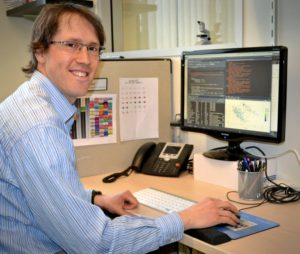Crunching Data to Cure Diabetes
in Research

Matt Dufort, PhD, fights type 1 diabetes one data point at a time.
Matt is a bioinformatician at Benaroya Research Institute at Virginia Mason (BRI), where he’s been using his “data wrangling” and analysis skills to find ways to prevent pancreatic damage in people living with type 1 diabetes. Bioinformatics is the science of collecting and analyzing complex biological data, like genetic codes.
“My role as a bioinformatician is to extract insights from data. There’s an amazing community of type 1 diabetes researchers working on how to cure the disease. That research is increasingly focused on large-scale biological data about patients,” he said. “I try to help the folks who best understand type 1 diabetes learn from that data.”
Matt was most recently crunching data for an initiative aiming to halt autoimmunity in people with type 1 diabetes. The project is a collaboration between BRI and Yale University, and the pilot project was funded by JDRF.
“This research is basically trying to wind the clock back on the autoimmune process to stop damage as early as we can,” he said. “I think there are two fronts in diabetes treatment…the first is how to help someone who has already lost their ability to produce insulin, and the other is how to keep people from losing the ability to regulate their own blood sugar. We’re trying to figure out ways to tweak the immune system so that it stops attacking the pancreas.”
In this study, participants in the third, symptomatic stage of type 1 diabetes (within a few months of clinical diagnosis) underwent treatments of the drug rituximab. Matt and other researchers reviewed gene expression – the process in which the information encoded in a gene is used to produce a functional product, like a protein – in blood samples from each study participant. This gave researchers a snapshot of what the immune system was doing in that person at that point in time. Researchers looked for commonalities among the results and focused on understanding the reason for variations between people on the drug vs. those on the placebo, and people on the drug who show improvement vs. those who don’t improve.
“Once we figure out why the drug works in some people and not others, we can try to identify ahead of time where it’s going to work and where it won’t be effective. Then we can personalize the treatment and only give this treatment to the people in which it will be most effective,” Matt said. “And in people where the drug is not working, we try to figure out why it’s not working and look at whether we can use that information to improve the treatment.’”
Results from this research show that a combination of therapies may be beneficial for patients who don’t respond to rituximab alone. This moves researchers closer to finding solutions that treat the cause of diabetes rather than the symptoms.
Though Matt is currently working to find the cure for type 1 diabetes, he wasn’t always driven by a desire to study biomedical research. His academic background is more ecology and evolution-based than immunology-focused, giving him a unique perspective as a data scientist. As a result, he’s drawn some interesting parallels between the two disciplines – namely, how multifaceted they both tend to be.
“There is so much complexity in the immune system,” he said. “I always thought about ecological systems as being so interesting because of their complexity and because it’s hard to understand what’s going on. The immune system is a lot like that – a complex community of interacting things, with different rules that govern how they work together.”
Written By: Hannah Nesich, Communications Coordinator, Benaroya Research Institute at Virginia Mason
